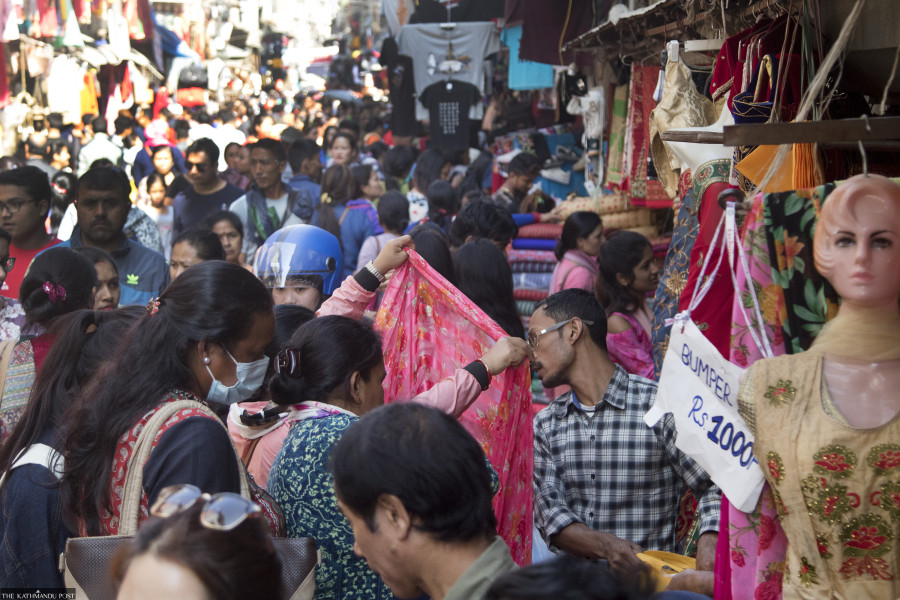Money
Economy limping as low consumer confidence bites
The country’s trade—import and export—is decreasing, suggesting that consumer demand has not increased.
Post Report
Nepal’s inflation is slowing almost as quickly as it rose. Banks are awash with liquidity. The foreign exchange reserve is at an all-time high. Interest rates have come down. Credit has started to pick up. The stock market is green, mostly. The country has a powerful government of the two biggest parties.
Despite several positive indicators, the country’s overall economy is still in a “slowdown” mode.
“We have to admit these facts,” said Finance Minister Bishnu Prasad Paudel, while addressing the 26th general assembly of the Society of Economic Journalists Nepal on Sunday.
“There is no demand in the market. Consumer confidence is low. Investors are hesitant to invest. There is no proper utilisation of liquidity,” he said.
He urged the private sector not to complain and move ahead hand-in-hand.
Nepal Rastra Bank Governor Maha Prasad Adhikari said there is some optimism after the slowdown.
“We expect the growth outlook to improve with resilient consumption and investment. Nepal’s economy has proved unexpectedly resilient.”
The country’s economy suffered multiple setbacks, starting with supply-chain disruptions in the aftermath of the Covid pandemic, a considerable surge in inflation triggered by Russia’s war on Ukraine, unstable politics or frequent changes in government. These factors have driven young people to try their luck abroad.
It followed a globally synchronised monetary policy tightening in the last fiscal year.
“Now the situation is better,” said Adhikari. “We have predicted the economy will recover this year.
The external sector is good, inflation is down, and the banking system has adequate liquidity.
“As a result, the central bank’s monetary policy had transitioned to an “easing, cautious” mode to address the demand of the private sector, which drives economic growth,” said Adhikari.
“We have brought down the interest rate, including the policy rate, just to revitalise the market activities. The credit mobilisation is growing.”
For example, according to Adhikari, the ongoing NADA Auto Show has shown the economy is moving in a positive direction. “Our objective is to instil hope and raise the morale of the private sector.”
The central bank said the measures to cut interest rates are intended to boost market liquidity and support economic activity in a low-inflation environment.
The monetary policy has reduced the upper ceiling interest rate corridor by 0.5 percentage points to 6.5 percent, and the policy rate has been reduced by 0.5 percent to 5 percent.
According to market analysts, people tend to invest if banks’ interest rates are low. This will allow liquidity injections in the market without being absorbed by the banks and the central bank.
The monetary policy stated that the high liquidity in the banking system would support businesses and individuals and ease the difficulties of the private sector.
The central bank said mobilising the banks’ liquidity through the private sector would support the federal government’s ambitious 6 percent economic growth target.
Rajesh Kumar Agrawal, president of the Confederation of Nepalese Industries, said that the slowed growth resulted from subdued demand. “For the last three years, we saw stalled growth. But now, there is optimism and hope that the economy will grow.”
He said that remittance earnings have increased to a record high, and the foreign exchange reserve is also at a historic high.
“But if we see the trade—both import and export—are decreasing. This suggests that the demand has not increased. And without the demand, Nepal’s economy cannot grow.”
For a country like Nepal, capital expenditure, the government investment, is crucial to revitalising the economy.
“If the capital expenditure remains the same as in the past, the economy will remain the same as we observed for the last few years.”
Experts say that the recent increase in the cost of living has been one of the significant challenges facing the economy over the past two years. Overall, inflation is decreasing, but consumer confidence still has not increased, which is reflected in the market.
“We think the intervention by the government to make market activities vibrant is not enough. We have to look for other measures, too,” said Paudel, stating that without the support of the private sector, the government alone cannot boost the economy.




 18.12°C Kathmandu
18.12°C Kathmandu













